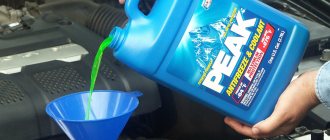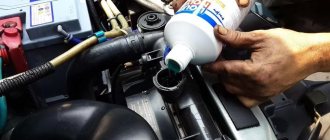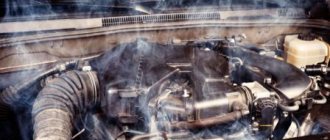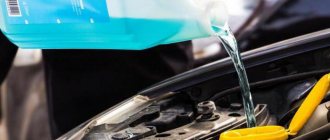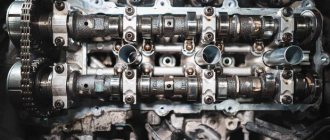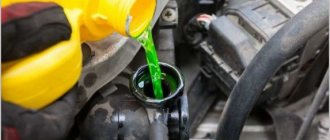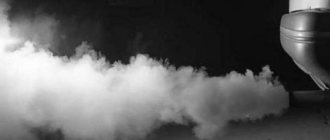The coolant consists of antifreeze, water, special additives, such as corrosion inhibitors, which protect the cooling system of an internal combustion engine from processes that are directly related to corrosion, and also protect the liquid itself from various kinds of negative influences and from thermochemical destruction. In addition, this substance protects all lubricants for the vehicle cooling system pump (pump).
Antifreeze is a specific compound. When this compound is mixed directly with water, the freezing point of the mixture drops significantly. Thus, antifreeze can be called almost any aqueous solution of inorganic salt (calcium chloride, potassium, sodium), alcohol, aniline, glycols, glycerin, carbinol and similar chemical elements.
In the modern world, the main coolants used in the automotive industry are liquids whose main component is ethylene glycol. This element must be diluted with water in the following proportions: ethylene glycol-water ratio – 1:1; 2:3 and also 1:2.
Propylene glycol antifreezes are less toxic substances and also have a significantly lower boiling point. This explains the high cost of this kind of substance.
All ethylene glycol coolants have certain quality specifications. This, in fact, is where the differences from each other lie: the set of necessary additives, the degree of dilution with water. All coolants based on glycol are highly toxic if ingested. Due to the fact that they taste quite sweet, pets and children are often poisoned by such chemicals. In some specific regions around the world, legislation has been passed to make it mandatory for manufacturers to add bitter flavoring additives directly to antifreeze. A person’s sensations when poisoned by this kind of substance have a direct effect on the central nervous system. This results in loss of coordination, vomiting and severe weakness. The best antifreeze is ethyl alcohol, which has a temperature of 40 degrees. In modern times, this antifreeze is not widely used, as it has a very high cost, volatility and flammability.
“Antifreeze” is a trade designation for coolant, the main difference of which from others is the quality of non-freezing.
This model was developed back in the USSR, however, at present, this word has already become a common noun. It is important to know that the basis of Antifreeze is ethylene glycol. Antifreeze is intended to cool the internal combustion engines of cars at any time of the year within certain temperatures that are specified in the brands and models of vehicles. The numbers 65 and 40, which appear in the brands of Tosol liquid, indicate the beginning of the freezing temperature of the model and make of the car. The lowest temperature needed to freeze an ethylene glycol-water system is about -70 degrees.
Boiling point of antifreeze and its other features
To move on to the features of this liquid, it is necessary to understand what coolant is, and also why such liquid is needed in the vehicle system. It is important to know that during the moments of direct operation and operation of the vehicle by the motorist, some special individual elements have the quality of strong heating. To avoid the failure of such devices, in fact, a special cooling system of the car is necessary. It is into this system that the coolant is poured, or, as it is commonly called in automotive slang, anti-freeze.
In general, if you look at it, antifreeze can easily be classified as one of the types of antifreeze. However, the whole point is that this kind of liquid appeared only a few decades ago, when the VAZ car appeared, and at that time it was of excellent high quality. If we talk about the current situation of all things, the situation has changed completely. This is due to the fact that a new “creation” has appeared on the automotive market - antifreeze, the quality of which is several times higher than the quality of domestic antifreeze. The whole secret of this difference lies in the fact that both one and the other type of coolant contain a complex of certain special additives. In antifreeze, these additives are selected in a functional manner to protect all metals (cast iron, aluminum alloys, copper, brass) from which VAZ cars and engines are made from oxidation.
That is why all owners of domestic vehicles should give preference to the domestic manufacturer of antifreeze antifreeze. Antifreeze is essentially an imported coolant. Based on this, it would be more advisable to use this liquid for those whose car is a foreign car. As for the freezing temperature itself, it is quite similar in both cases, only the boiling point of antifreeze is 120 degrees, and antifreeze is 110 degrees. The difference, it would seem, is not big, but during the periods of solstice and summer heat it plays its assigned role.
Why does antifreeze boil and how to notice it?
If antifreeze liquid begins to boil, the most dire consequences can occur. It is because of them that a huge amount of capital investment may be required for partial repairs or a complete replacement of the cooling system, or even worse, the car engine. It will not be difficult to understand that this problem has arisen in your own vehicle: steam will “fly out” from under the hood of the car in all respects; in addition, the engine power will decrease significantly, while fuel consumption will increase significantly. In addition, it is important to know that if the engine boils frequently, its service life is significantly reduced. Sometimes, such an indicator can reduce the period by two or three times.
This problem occurs for a number of specific reasons. Often, this malfunction occurs due to low-quality coolant. That is why you should select the coolant very carefully; you should not chase the price, but you should purchase it only from reliable points and car services. In addition, the reasons for this phenomenon are clogged radiator, poor sealing of the cooling system and insufficient fluid level. In addition, if a radiator fan, thermostat or pump fails, similar problems may arise, as a result of which you can pay very dearly for your own negligence and absent-mindedness.
We recommend: Front wheel hub bearing - what is it?
How to prevent antifreeze from boiling?
In addition to the fact that it was important to learn about the reason for the boiling of antifreeze in the expansion tank, there is no less important knowledge. This information is to protect the device from boiling, to prevent this process, and how not to make a mess if such a situation arises for a car enthusiast. It is important to know: if, unexpectedly for the car owner, the coolant boils while the vehicle is moving, and characteristic white steam begins to appear from under the hood, then urgent measures must be taken.
The first aid in this situation will be to immediately stop and further cool the system. After this, you need to immediately identify the cause, and then eliminate it as quickly as possible.
There is an elementary method that helps prevent this type of situation from occurring. The easiest way is to constantly take care of the car, timely maintenance of the vehicle, as well as a daily procedure for checking the condition of the car. In cases where even the slightest hint or prerequisite for the occurrence of a “disease” arises, everything must be stopped and treated immediately. In addition, an important element is the use of high-quality liquid. It is high-quality substances that can be universal and suitable for all types of cars. It is important that during the moments of its movement, the internal combustion engine heats up to a temperature of 90 degrees, while antifreeze is capable of taking about a third of this heat. That is why the importance of this kind of fluid for the successful functioning of a vehicle is very difficult to overestimate. In terms of importance, it can be compared to motor oil or brake fluid. Consequently, the entire cooling system in a vehicle plays one of the most important roles.
A little physics
It is incorrect to talk about the boiling point of antifreeze in the specifics of antifreeze, since, firstly, antifreeze has a certain chemical composition, and its thermophysical characteristics are determined not only by temperature, but also by pressure. Secondly, antifreeze, which at one time was created exclusively for domestically produced engines, contains additives that ensure not only the operation of the car at low temperatures, but also its protection from a number of unfavorable factors:
- corrosion;
- wear;
- cavitation.
Antifreeze, unlike antifreeze, does not have a lubricating effect, and wear reduction is achieved due to a decrease in the temperature of the moving elements of the drive, with an increase in which the gaps are selected and the friction coefficient naturally increases.
If everything is more or less clear with the permissible temperature (no more than 90ºС), then with the pressure in the engine the situation is more complicated. To protect the engine from overheating, antifreeze is pumped at elevated pressures, which also affects the temperature of the liquid. For most brands, the actual pressure in the cylinder block is at least 1.2...1.3 at: it is then, according to the Clausius law, that the maximum temperature required for boiling liquids increases. Thus, the theoretically permissible boiling point of coolants can be 110...112ºС.
Differences between antifreeze and antifreeze in terms of performance
Antifreeze differs in its performance characteristics from antifreeze: it is worth remembering that the Soviet refrigerant is made according to an outdated recipe and quickly loses its characteristics when it reaches a high temperature. Also, the Soviet refrigerant is not able to serve as a full replacement for antifreeze and is not able to protect the car engine when it reaches a temperature of 100 degrees.
It is also important to consider: if you are planning to replace antifreeze in your foreign car, then remember that the color will help in choosing the right mixture for the engine and, in general, can be the best distinguishing feature of a company that develops and manufactures engine coolants.
Antifreeze in its general consistency is slightly runny in comparison with the same antifreeze and therefore resembles water.
How to distinguish one refrigerant from the other? To be able to more accurately find out what you purchased for the car and protect your engine from counterfeiting and possible breakdowns during the operation of the car, try to pay attention to the size of the container in which the mixture in the form of refrigerant is actually stored. For example, many companies with a certain reputation try to value it and put a certain type of designation on the canisters with pressed letters and a multi-stage label.
What to do when antifreeze boils
If the antifreeze begins to boil, thick smoke comes out from under the hood, and the engine temperature gauge shows more than 100 °C, then you need to act immediately. First, you must immediately remove the load from the engine. To do this, turn on neutral gear and stop smoothly without turning off the engine. At the same moment, you need to turn on the fan or heater so that the power unit of the car cools down faster. We turn off the engine only after the car has completely stopped, but leave the heater on.
Smoke from under the hood of a car
Next, open the hood of the car to ensure air flow to the engine, and wait about 20–30 minutes. Do not open the expansion tank under any circumstances, otherwise antifreeze may splash into your face in a powerful stream! After the engine has cooled down, you need to call a tow truck. If this is not possible, you need to perform the following steps.
First, open the expansion tank and add a small amount of antifreeze. Next, we start the car and slowly move towards the nearest workshop. While driving, you need to carefully monitor the engine temperature. If the sensor needle approaches the 100 °C mark, then the car needs to be stopped and only after a while continue moving.
Adding antifreeze to the expansion tank
If you already have experience repairing the cooling system, you can try to fix the problem yourself. To do this, you need to clean the cooling radiator, replace the pump and fan. After this, it is necessary to disconnect the pipes from the thermostat and eliminate the air lock. If necessary, you need to replace the coolant temperature sensor. However, it is best to entrust such work to specialists. You should constantly monitor the temperature of the power unit and be sure that the refrigerant will not boil or freeze in your car.
Why does antifreeze (antifreeze) boil, and what should I do?
It is important for every car enthusiast to know the reasons why antifreeze boils and what needs to be done in this situation. Difficulties usually arise due to several reasons that arise from several vehicle malfunctions. The result of such malfunctions is overheating of the motor and, in some cases, its destruction.
If you use the physical properties data, the boiling point of antifreeze should be 100 degrees. Although, it happens that car manufacturers increase this value higher - up to 108 degrees. This also applies to regular types of antifreeze, which also boil at this temperature. It is not possible to set this parameter with an error of up to one degree, because it depends on each manufacturer individually.
Types of malfunctions that cause antifreeze and antifreeze to boil
Malfunctions may be the result of breakdowns in several components of your car. Consider these options below:
water pump
The reason why the antifreeze boiled could be due to the fact that there were malfunctions of the water pump going to the cooling system. This malfunction occurs in engines with a rotating pump pulley from the timing belt. In order to avoid this problem, it is necessary to monitor the belt drive, namely its tension, and if it weakens, adjust it. In other cases, the speed of movement of antifreeze through the system becomes less, which leads to a deterioration in heat removal directly from the engine.
Cooling radiator
If antifreeze boils in your car, it is recommended to pay attention to the cooling radiator. Let's look at the reasons why the radiator may be faulty:
- Scale may appear in the pipes leading to the radiator, which, being on the inner walls, reduces the required thermal conductivity of the pipes. The consequence of this is that the antifreeze cools more slowly and does not remove heat sufficiently.
- The inside of the radiator may become contaminated with debris that can fall directly into the coolant. Because of this, the throughput is partially reduced and the system becomes ineffective.
- Your car has been moving for a long time at a relatively low speed. This problem occurs when operating a car in big cities (traffic jams), or in off-road conditions. As a result, the car moves slowly for a long time, and the air flow that flows through the radiator is not enough for cooling. If antifreeze has boiled in your car, you should pay attention to the fan, which might not turn on when the temperature rises.
This is what a clogged radiator looks like
Thermostat
Another option in which antifreeze may boil may be a malfunction of the thermostat device that controls the temperature. With this malfunction, the valves also remain in a fixed position, and the antifreeze moves in a small circle. Simply put, it does not cover the radiator itself. Insufficient circulation causes the coolant to quickly overheat. If your antifreeze still boils, then you need to open the cap on the expansion tank, doing this carefully. This will allow excess vapors to leave the system.
To make sure whether the thermostat is working or has failed, you need to find two pipes under the hood that go directly to the device. They carry antifreeze directly to and from the radiator. Touch the hose that carries antifreeze to the radiator to compare it with the pipe that comes from the radiator. If it is hotter, then the thermostat needs to be replaced.
Also, the reason for boiling of antifreeze may be its small volume, which is checked by the marks located in the tank. The fan may also be damaged.
What can be the danger of boiling?
Some car enthusiasts do not sufficiently understand the consequences of overheating antifreeze for the engine and continue to operate the car. All this can lead to engine damage, as well as a number of other breakdowns. There are three parameters for engine overheating due to antifreeze boiling. This is low heat, as well as medium and high heat. Let's look at each in more detail.
Slight overheating
If your antifreeze has boiled, and a little time has passed since this malfunction, no more than 10 minutes, then problems with the engine are excluded. The cause of this malfunction may be a malfunction of the thermostat, as well as the fan located on the radiator.
If the sensor signal directly shows overheating on your dashboard, you must immediately turn off the engine. Otherwise, the pistons in your engine will begin to melt. For modern cars, it is not dangerous if slight overheating is detected. That is why, in this case, a motorist does not need to seek help from a car repair shop. This is true even if you have smoke coming out from under the hood.
Average superheat
When antifreeze boils for 20 minutes or more, a motorist may encounter more serious problems:
1. Microcracks may appear, the head and the cylinder block itself may become deformed.
2. Engine cylinder block and head. There is a gasket between them. It may melt and burn.
3. Piston rings. There are partitions between them. They may be damaged.
4. Seals. They may leak oil.
The stages of overheating presented above may be the result of a low level of vehicle maintenance.
Expansion tank and antifreeze boiling in it
Severe overheating
This malfunction can damage the engine. If your antifreeze boils and the engine temperature exceeds all permissible values, then all parts and mechanisms of the engine are at risk. These are not all the troubles that can await a car enthusiast. If you do not stop the engine in time, it may explode, and the consequence of this may be a danger for the driver himself, as well as for his passengers and third-party road users.
It is worth recognizing that this situation, fortunately, rarely occurs, and often the motorist has time to take the necessary measures. With severe overheating, a “wave of destruction” effect occurs. It affects almost all elements of the system. The pistons light up and then begin to melt. After this, the metal begins to drip, damaging the cylinder walls. Then, interference occurs that prevents the pistons from moving normally, and because of this they become deformed.
If the engine continues to operate with deformed pistons, this leads to breakdown of the lubrication system. The lubricating properties of the oil inside the engine disappear, resulting in breakdown of the engine's rubbing parts. Melt products fall directly onto the crankshaft and prevent it from rotating optimally.
The result of the events presented is that the valve seats simply fall out, after which the pistons mechanically act directly on the crankshaft, which is destroyed because of this. Eventually, the piston passes through the wall in the cylinder block, and after this the engine fails completely.
What to do if your antifreeze or antifreeze boils?
We have already described situations that are extremely dangerous, but with proper actions they can be avoided in the event of a malfunction.
If antifreeze boils, and if the temperature sensor readings increase above the required 100 degrees, you need to perform the following actions:
- Relieve the engine load by moving the gearshift lever to neutral, moving it until the car stops moving. Then, turn on the heater as well as the fan, this will help lower the engine temperature.
- After stopping the car, turn off the engine, but do not turn off the heater. It will help the cooling process faster.
- Get out of the car and slowly lift the hood. After this, more cool air will flow to overheated devices. Wait a certain amount of time. Under no circumstances should you immediately unscrew the cap that is located on the expansion tank, because the hot liquid located there, splashing out, will burn your hands or other areas of the skin.
- After half an hour, stop the car, which will help you on a rope to get to the nearest service station or call a tow truck.
After the engine has cooled, you need to open the expansion tank cap and add antifreeze to the desired level. The stove is turned on. Pay attention to the volume of fluid in the system reservoir. If there is not enough antifreeze, do not immediately add new fluid, because a rapid change in temperature can cause problems in the system.
While driving, monitor the engine temperature, the values of which should be operating. If it is more than 100 degrees, turn off the engine and wait until it cools down. If you do not take these actions, the antifreeze will boil, and then damage to the main components of the car engine will occur. The consequence of this may be the replacement of the gasket located in the cylinder block, and may also lead to a major overhaul of the entire engine.
Video: VAZ 2110. What to do if antifreeze boils at 85 degrees?
If the video doesn't show, refresh the page or click here
What to do in case of boiling?
If Antifreeze is boiling, smoke is coming from under the hood, and the engine temperature gauge needle shows more than 100 degrees, then you need to do the following:
- First you need to immediately stop loading the motor. That is, you need to engage neutral gear and move until it comes to a complete stop, without turning off the engine. At the same time, turn on the heater or fan so that the engine cools down at least a little;
- After stopping the vehicle, the engine must be turned off, but the stove does not need to be turned off. A working heater will allow the engine to cool down a little;
- open the hood of the car to provide airflow to the engine;
- then you need to wait 20-30 minutes;
- It is strictly not recommended to open the expansion tank with coolant, otherwise hot antifreeze may simply spray out of it and burn the driver’s skin;
- when 30 minutes have passed, look for someone to take you to the service station. You can take the car towed or call a tow truck;
- if going to a service station is not an option, then open the expansion tank and add refrigerant, then close the hood and drive to the nearest service station with the heater on. Look how much fluid is in the expansion tank. If it is not there, then do not rush to fill in the refrigerant: sudden cooling is harmful to the system. In this case, it is necessary to control the engine temperature: if it exceeds 100 degrees, then stop the car and wait until the temperature drops. If the temperature goes beyond 100 degrees several times, then there is a possibility of motor failure. If the engine misfires, then it is necessary to change the gasket on the cylinder block;
Sediment in the pipe after using low-quality refrigerant
We recommend: Filling and lubrication work
If you have the necessary knowledge, you can try to fix the breakdown on the spot.
To do this, you need to diagnose the parts and, if necessary, replace:
- thermostat;
- clean the cooling radiator;
- replace the pump;
- change the fan;
- disconnect the pipes from the thermostat and get rid of the air lock;
- Replace the antifreeze temperature sensor.
It is better to entrust such work to a specialist if you are not confident in your abilities. The temperature of the engine must be constantly monitored to prevent such malfunctions from occurring, but if it boils, then follow the steps described above.
At what temperature do antifreeze and antifreeze boil?
Antifreeze is essentially a type of antifreeze and appeared on the market decades ago along with the appearance of the first VAZ cars. At that time he had excellent characteristics. Each coolant differs from other liquids in the presence of a certain type of additives designed to protect engine elements from corrosion and wear. The additives contained in antifreeze are best suited for VAZ engines. Antifreeze is of the best quality and is intended for engines of imported cars.
To distinguish between types of coolant, dyes are added to them. Usually the colors are red, blue or green. Thanks to this, and the fact that the expansion tanks are made of translucent plastic, the driver can quickly and accurately determine whether there is enough coolant in the system. When the coolant loses its original color, it indicates that it is time to replace it. Next, I will talk about in what situations antifreeze can boil.
The freezing point of antifreeze and antifreeze is the same (depending on the coolant concentration), and the boiling point of antifreeze is slightly different from the boiling point of antifreeze. For antifreeze the boiling point is 110 °C, and for antifreeze it is slightly higher - 120 °C. The temperature difference is small, but in the hot summer it can be significant.
The above values for the boiling point of antifreeze and antifreeze are correct for a fully functional engine cooling system. If there are foreign impurities in the antifreeze or antifreeze or the expansion tank cap has lost its tightness, the boiling point may be lower.
How the cooling system keeps the temperature within specified limits
Let's start with the fact that after starting a cold engine, the pump (water pump) forces coolant to circulate through the channels of the cooling system. In this case, the channels can be divided into a large and small circle.
Small circle - circulation occurs inside the cylinder block and cylinder head. Large circle - liquid enters the cooling radiator. The thermostat is responsible for opening the large circle, which is completely closed when the engine is cold. As the liquid heats up, the thermostat begins to open, after which antifreeze or antifreeze enters a large circle.
By the time the liquid warms up to 80-90 degrees, the thermostat will be completely open and the liquid will begin to circulate only in a large circle. Once the temperature drops, the thermostat will partially or completely close. In a nutshell, this is the scheme for regulating the operating temperature of the engine and coolant.
In parallel, a coolant temperature control sensor is installed on the engine. This sensor, if necessary, activates air cooling by sending a signal to turn on the fan.
As for the properties of the coolant, boiling under atmospheric pressure begins at 108-110 degrees. However, before boiling begins, vapor plugs begin to form in the system, which disrupt the operation of the internal combustion engine cooling system. As a result, the motor may overheat.
We also recommend reading the article about what you need to know about the coolant that is used in the cooling system of an internal combustion engine. From this article you will learn about the properties, composition and features of coolant, different types of liquids, features of their mixing, etc.
To minimize risks, an expansion tank is integrated into the system, which also has special valves. If the system pressure rises above the specified limits, then the release valve opens. This way you can get rid of active steam formation.
Even after heating (while the engine is cooling), the volume of coolant also decreases, and a vacuum forms in the system. In this case, the inlet valve opens to equalize the pressure difference.
It is important to understand that a breakdown of the exhaust valve will result in a lower coolant boiling point in the system. If the valve is completely jammed, then excess pressure can cause rupture of pipes and damage to the radiator, antifreeze leaks, etc.
Refrigerant Application
The quality of the coolant greatly affects the thermal conductivity, operating and maximum operating temperature. To determine the boiling point of antifreeze, you need to pay attention to quality. For example, the boiling point of antifreeze “A 40” is 108-110 degrees.
Sometimes car enthusiasts come across a low-quality liquid that boils even earlier than water. The only way to reduce the likelihood of buying a counterfeit is to purchase a brand of antifreeze or antifreeze that has already been used.
For any antifreeze, the boiling point depends on pressure. As a rule, with increased pressure, the upper limit shifts upward. The coolant freezes at forty to sixty degrees below zero. Typically, antifreeze is changed after two to three years or every eighty thousand kilometers.
Water and antifreeze
In the first car models, ordinary water was used to cool engine systems. But at one hundred degrees the liquid boils, so under conditions of increased loads it is very ineffective. And besides, water freezes when the thermometer is zero. This fact has more than once caused various car breakdowns in the winter.
Chemists and engineers thought about the problem for a long time and found a solution. The new liquid - antifreeze - has a boiling point of 108-125 degrees Celsius. Of course, the spread in the value is quite large, but the figure depends on the type of additives in the composition, the pressure in the system and the overall quality of the liquid.
The cheapest antifreeze is produced in violation of traditional technology, which affects the composition and properties. Sometimes drivers complain about liquids that boil at eighty-five degrees. Undoubtedly, this is dangerous for the car. Sometimes it is better to pour distilled water into the tank rather than an incomprehensible mixture. You shouldn’t save too much on antifreeze, because car repairs can ultimately cost much more.
Pressure dependence
At atmospheric pressure, high-quality antifreeze boils, reaching 180-110 degrees. But increased pressure in the system also increases the maximum permissible value for boiling liquid.
If the system is working properly, the upper limit for antifreeze can be shifted to plus 130 degrees. Of course, the system must be completely sealed. The antifreeze tank must be tightly closed. This largely depends on the serviceability of the valve on the expander cap. A leaky cooling system causes the antifreeze to quickly overheat. Under pressure, antifreeze increases the engine's resistance to overheating.
Boiling point of antifreeze
Initially, on the first cars, water was used as a coolant. The boiling point of water is 100 degrees Celsius. The reasons why it was decided to abandon water lay in its low boiling point, which was not designed for heavy loads, and its freezing in winter. After all, when it froze, it turned into ice, and its volume expanded significantly. Such phenomena led to the fact that the cylinder block simply cracked and the entire engine failed, the block of which could only be replaced.
Such disadvantages are absent in antifreeze. The fact is that antifreeze has a certain chemical composition that allows it to withstand fairly low temperatures, which makes it possible for the car to operate normally in winter. In addition, the boiling point of antifreeze is much higher than that of water and is 125 degrees Celsius.
However, such a value as temperature can vary from 108 to 125 degrees. This is due to the chemical composition of the coolant, which, accordingly, changes the boiling point. Changing the composition makes the production of antifreeze more economical, the price for it falls, but at the same time, the boiling point also decreases. Therefore, when buying antifreeze, you should not pay special attention to savings, since the proper cooling of your engine will depend on this.
You should be especially careful with antifreeze with qualitative inconsistencies. Typically, such coolant costs quite little, which is tempting for drivers. However, the boiling point of some specimens is even 85 degrees, which is dangerous for a car engine. Therefore, be careful and do not buy low-quality coolant. This will save you a lot of nerves and money.
Thermophysical properties of domestically produced antifreezes
In Russian-made engines, it is advisable to use antifreeze brands Phoenix, Sintec and the like. Their performance limits are:
- For antifreeze A40M: -40…+108ºС.
- For antifreeze A65M: -65…+108ºС.
- For antifreeze A60M: -60…+105ºС.
- For antifreeze TL-30 Premium: -30…+108ºС.
At temperatures in the engine higher than those specified, the antifreeze boils.
The coefficient of volumetric expansion of antifreeze is in the range of 1.09...1.12. Other indicators are determined by the technical requirements of GOST 28084-89.
The possible boiling point of antifreeze is also estimated by the pressure value:
- At P = 1 atm Tbp = 105ºС;
- At P = 1.1 at Tbp = 109ºС;
- At P = 1.3 at Tbp = 112ºС.
The main manufacturer of antifreeze in the country is PKF "MIG and Co" (Dzerzhinsk, Nizhny Novgorod region).
At what temperature does antifreeze freeze?
Having an understanding of the conditions under which Antifreeze boils, it will not be superfluous to find out at what temperature it freezes. So what is the freezing point of coolant? This may not seem like a difficult question. After all, if antifreeze boils at 100 °C, then it should freeze at 0 °C. There are some nuances here.
Freezing temperature of antifreeze
We recommend: Pros and cons of gearboxes: what to choose: mechanics, automatic, CVT or robot
Antifreeze is produced by dozens of companies throughout Russia. Each of them has its own secrets for creating antifreeze, a different composition and amount of impurities, and, accordingly, they indicate different conditions for the use of their products. Finding out at what temperature Antifreeze freezes is very simple. For example, if the antifreeze package is marked as OZh-40, this means that freezing of this composition begins at a temperature of –40 °C.
Marking OZh-40 on the coolant packaging
In auto stores you can find fluids labeled OZH-20, OZH-60 and others. However, the most optimal would be antifreeze labeled OZh-40. Such antifreezes can be used under any conditions and in different regions of our country. They effectively cool the car engine. As practice shows, antifreeze of this brand works especially well in combination with Total motor oil. Together they supply the power unit with everything it needs, ensuring stable operation of the power unit.
At what viscosity does antifreeze boil?
Graph of the general dependence of the viscosity index on the temperature value
The picture is surprising, because liquids, even if they are of the same type and have the same shade, should never be mixed with each other.
In fact, the refrigerant is almost always made in the same shade, in other words, antifreeze usually does not have any color, but already at the last stage of manufacturing the company - manufacturers add a simple dye of a certain shade to it in order to give the mixture some color. then a special or individual shade.
By the way, you don’t have to think about this topic, since no dye almost ever reduces the performance of the engine and does not affect the properties of antifreeze.
There are also often rumors that companies also pour certain lubricating additives into the antifreeze; these are essentially just rumors that have nothing in common with reality.
As for the average freezing point of the mixture, the boiling point of antifreeze is about – 110 degrees, and the boiling point of antifreeze is about – 120 °C. At the same time, the differences do not seem to be particularly noticeable, but during the heat of the street this plays a certain role.
Temperature and causes of boiling
Boiling fluid in the engine is a fairly common breakdown that occurs as a result of any malfunction in the cooling system. If the engine boils, then driving the vehicle is strictly prohibited, since frequent boiling may cause the engine to fail altogether. Then major repairs may not even help the car owner.
There can be several faults that can cause any refrigerant to boil in the expansion tank. But all of them are associated with breakdowns that lead to overheating of the motor. The boiling point of "Antifreeze", be it blue, red or green, is 100 degrees Celsius, but liquid manufacturers, as a rule, increase this figure to 108 degrees. As for traditional antifreezes, they also boil at the above temperature.
Blue and green refrigerants
It is impossible to specifically indicate the temperature to the nearest degree, since it is determined by each manufacturer.
Let's consider malfunctions that can cause refrigerant boiling:
- thermostat malfunction;
- malfunction of the radiator of the cooling system;
- malfunction of the centrifugal pump (pump);
- insufficient refrigerant level in the system;
- fan failure;
- air lock in the cooling system;
- failure of the refrigerant temperature sensor.
Thermostat. If this element breaks, its valves will jam in one position. That is, the refrigerant will flow in the system through one of the circulation circles (small), and the liquid will not be able to cool properly. So the antifreeze will boil and this can be seen by opening the cap of the expansion tank, since vapors from the system will exit through the tank.
To find out which thermostat is working or not, you need to open the hood and find two pipes leading to it. These hoses carry fluid to and from the radiator. If the pipe supplying coolant to the radiator is hotter than the second hose, then it’s time to change the thermostat.
A clogged radiator is one of the reasons for engine boiling.
The cooling radiator can also cause fluid to boil in the system.
It fails in several cases:
- if the radiator core is clogged with dust and sediment from “Antifreeze” (in this case, the air flow passing through it is reduced);
- scale and sedimentation inside the pipes (the thermal conductivity of the hoses is significantly reduced, as a result of which the liquid is not cooled sufficiently);
- the vehicle moves at low speed (the air flow through the radiator core to cool the antifreeze is insufficient).
The refrigerant can also boil in the cooling system if the pump is not operating efficiently. In particular, this applies to those engines where the pump pulley receives torque separately from the gas distribution device. In this case, a decrease in the pulley rotation speed may occur due to a weakening of the drive belt tension. If the belt is loose, the rate of circulation of the refrigerant is significantly reduced, which can cause it to boil.
Failure of the cooling fan, the formation of an air lock, as well as insufficient fluid level in the tank can cause the engine to boil in the system.
Car engine boiling
Causes and solutions
One of the banal reasons why antifreeze boils in the expansion tank is that the coolant level is insufficient. Typically, in such a situation, the corresponding light on the dashboard lights up. But you can, for example, on a bright sunny day and not notice the alarm signal. The temperature sensor may also fail or the lamp itself may simply burn out. Therefore, before a long trip, it is recommended to check the antifreeze level manually. And at the same time, inspect the pipes suitable for the expansion tank and make sure that they are intact, that is, that there are no leaks. But there are other “culprits” for coolant boiling.
Thermostat
This is the second main reason why antifreeze boils. The thermostat circulates antifreeze throughout a large circle of the cooling system. When starting the engine, in order to warm it up faster, the valve in the device closes and the liquid does not enter the radiator, moving in a small circle. If the thermostat is faulty, after the engine reaches operating temperature, the coolant still does not circulate through all the lines, which causes overheating. It is easy to check the functionality of the thermostat. To do this, just touch the pipe coming from the radiator below: if it is cold, the device is faulty.
Thermostat built into the cooling system
There is a small nuance here: the thermostat can periodically or constantly open halfway. It is difficult to determine this, because the device sometimes works normally, sometimes it doesn’t. In this case, you should check all other possible causes (described below) that cause the engine to overheat. If everything is in order everywhere, you need to install a known-good or new thermostat.
Broken radiator cap or expansion tank
This malfunction leads to an increase in pressure in the cooling system. At the same time, no alarming signs are detected on the instrument panel: the arrow indicating the temperature is in the desired sector. The problem is solved by purchasing a working cap with a valve that releases excess liquid back into the expansion tank.
This is what an expansion tank with a plug looks like
Radiator
Its poor performance is most often associated with natural wear and tear or constant use of the car in difficult road conditions, for example, when there is a lot of dust in the air. As a result, the radiator becomes clogged from the outside, and antifreeze boils in the expansion tank. Problems may also arise inside in the form of scale in the pipes and sediment. The latter can be formed due to low-quality antifreeze. To solve the problem, you will have to remove the radiator and wash it thoroughly. As a temporary measure, pour a special additive into the cooling system, which, albeit a little, will clean the internal lines.
This is what a clogged radiator looks like
Poor quality coolant and air lock
It is this that influences the efficiency of heat removal from heating parts. Meanwhile, the constant need for the product intensifies the activity of underground workshops producing counterfeits. “Left” antifreeze can boil earlier than even water. The “correct” coolant has a boiling point of +108 degrees or more. The boiling point is directly related to pressure: when it rises, the upper limit moves even higher. High-quality antifreeze hardens at 40-60 degrees below zero. The coolant change period is 2-3 years or 80 thousand km. Here again, everything depends on the operating conditions: if they are severe, new fluid needs to be added more often.
An air lock in the system can also lead to antifreeze boiling, because in this case the volume of antifreeze is insufficient. You can solve this problem yourself.
Below we consider the process of removing the “plug” using the example of VAZ 2109, VAZ 2110, 2114, 2115:
- As the laws of physics say, air accumulates in the highest place, and in a car this is the throttle valve assembly. Find its heating pipes (there are two of them) and remove one of them.
- Unscrew the expansion tank cap and cover the neck with a clean rag.
- Blow into the tank until antifreeze flows out of the removed pipe (or fitting) instead of air. As soon as this happens, immediately put the pipe back on.
If you find this method difficult, you can use another method:
- start the engine and warm it up to operating temperature;
- turn off the engine, and, as in the previous version, unscrew the clamp on the throttle valve pipe and wait until the antifreeze flows, then put the pipe back on.
An even simpler method requires driving up the hill in front so that the radiator is at the highest point. Put the car on the handbrake.
Further:
- unscrew the expansion tank cap;
- sharply press the gas pedal several times: at the same time ask an assistant to add coolant to the expansion tank;
- Continue the procedure until no more air bubbles are released.
In the same way, air is removed from the cooling system of the “classic” VAZ2101-2107. The only difference is that here you will also have to unscrew the radiator cap, which the 2108-2115 does not have.
Water pump malfunction
When it occurs, the pump stops pumping liquid in the system, which leads to the cessation of heat removal from the heating engine parts. The cause of pump failure is wear or poor quality of the part. Usually the bearing fails (sometimes accompanied by a characteristic whistle) of the shaft, which ends with the device jamming. Less often, the impeller breaks, and then extraneous noise is heard when the engine is running. In any case, the part needs to be changed.
Pump with broken impeller
As you can see, the reasons for boiling are different. Troubleshooting may take several minutes or one or two days. You can carry out the work yourself or you will have to go to a car service center. Therefore, it is wiser to undergo maintenance on time, monitor the tightness of the connections of the pipes (tighten the clamps), and clean the radiator, especially after a hard road.
What to do when it boils
If you suspect that the coolant is boiling, the question arises, what to do in this case? As mentioned above, first of all you need to stop, open the hood to give the engine a chance to cool down faster and carry out initial diagnostics.
If the level of antifreeze or antifreeze in the expansion tank is low, it is necessary to add coolant to the required amount, eliminating the cause of the leak if possible. If this is not possible, then periodically stopping and adding coolant will make it possible to get to a parking lot or service station.
A poorly tightened or defective expansion tank cap can also cause antifreeze to boil. In this case, it is necessary to tighten it tightly or, if possible, replace it.
A failed engine cooling radiator fan makes it possible to reach a parking spot at low speed in the city. If you are outside the city limits, then it is better to use towing or a tow truck if you have an automatic transmission.
And the most common reason why the coolant boils is standing in a traffic jam in the summer heat. If you see that the temperature sensor on the instrument panel has crossed the red line, you should not wait for steam to appear from under the hood. It's better to stop, turn off the engine and open the hood. After the engine has cooled down, you can continue driving.
- A secondary useful characteristic of the refrigerant is its low freezing point and high boiling point (this will be discussed in the article).
- In general, this refrigerant is made on the basis of several types of atomic alcohols, including antifreeze made on the basis of ethylene glycol or propylene glycol. Most often based on ethylene glycol, especially for modern mixtures for cars. One of the main qualities of antifreeze is its high boiling temperature.
- It is also important to consider that another task of the engine coolant, after the car engine has been cooled to a comfortable temperature, is high-quality heating in the cabin.
- The ideal temperature for cooling an engine that is running all the time is around minus 90 degrees.
- Propylene glycol is the best characteristic for engine operation, but it itself is not particularly harmful to nature, which cannot be said about ethylene glycol. It has a much more minimal percentage of rapid evaporation. In addition, the essence of circulation in the operation of a car’s cooling system is practically no different in the first or second option.
Boiling point of antifreeze and antifreeze of different classes
Antifreeze is a substance used as a coolant in the cooling system of vehicles. However, many car owners, out of habit, call antifreeze antifreeze. The latter is a brand of antifreeze. It began to be produced back in Soviet times, and there was no alternative to this product at that time. Antifreeze and antifreeze differ in composition:
- antifreeze contains water and ethylene glycol, as well as additives based on salts of inorganic acids;
- antifreeze also includes ethylene glycol or propylene glycol, water and additives. The latter are used on the basis of organic salts and improve the anti-foam and anti-corrosion properties of the coolant.
Antifreeze comes in different classes, each characterized by its own color marking:
- G11 - blue or green, or blue-green;
- G12 (both with and without pluses) – red with all shades: from orange to lilac;
- G13 - purple or pink, but theoretically they can be any color.
Antifreeze varies by class, color and characteristics
The main difference between classes of antifreeze is the different bases and characteristics of the liquids. If previously water was poured into the car cooling system, which boiled at +100 °C, then the use of the type of coolant in question made it possible to increase this value:
- blue and green antifreezes have approximately the same boiling points - +109–115 °C. The difference between them is the freezing point. For green antifreeze it is about -25 °C, and for blue antifreeze it is from -40 to -50 °C;
- red antifreeze has a boiling point of +105–125 °C. Thanks to the additives used, the likelihood of it boiling is reduced to zero;
- G13 class antifreeze boils at a temperature of +108–114 °C.
The consequences of boiling antifreeze
If the coolant boils for a short time, nothing bad will happen to the engine. However, if you continue to operate the machine with the problem for more than 15 minutes, the following consequences are possible:
- damage to the cooling system pipes;
- leakage in the main radiator;
- increased wear of piston rings;
- The lip seals will cease to perform their functions, which will lead to the release of lubricant to the outside.
Antifreeze may boil due to coolant leaking from the system
If you drive a car with boiling antifreeze for a long time, more serious damage is possible:
- destruction of valve seats;
- damage to the cylinder head gasket;
- destruction of the partitions between the rings on the pistons;
- valve failure;
- damage to the cylinder head and the piston elements themselves.

